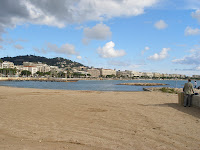 Friday night we headed for Toit pour Toi, tipped by the VLM airlines in-flight magazine. Well, almost. Its sister restaurant La Table des Guilloux, owner of two Michelin stars, nabbed the review as one of Luxembourg’s greatest restaurants. Turns out the son of the proprietors, Katell Gillou, has opened his own place across the courtyard from mere et pere. Though lacking its own stars, I find it difficult to imagine being more satisfied than we were with the junior experience.
Friday night we headed for Toit pour Toi, tipped by the VLM airlines in-flight magazine. Well, almost. Its sister restaurant La Table des Guilloux, owner of two Michelin stars, nabbed the review as one of Luxembourg’s greatest restaurants. Turns out the son of the proprietors, Katell Gillou, has opened his own place across the courtyard from mere et pere. Though lacking its own stars, I find it difficult to imagine being more satisfied than we were with the junior experience.Both restaurants occupy a converted farm complex in the suburb of Schouweiler. La Table occupies the old manor house, Toit pour Toi the barn across the wide courtyard. Both have expansive walls of glass allowing a view into their warm interiors. The former is all classic elegance, the latter cool, quirky and modern. There’s a flat-roofed, rectangular, glass-walled addition at the barn’s back that, I suspect, looks out over quite a magnificent view. It was dark, but the complete absence of lights implies one of Luxembourg’s typical field and forest vistas. We, however, ate in the main barn building.
Rarely have I seen such a delightful conversion. You ascend from the stone-paved ground floor up a wide wooden stair, currently overhung by a 20-foot Christmas tree suspended upside down and covered with blue lights and red and clear glass ornaments. The peaked roof, held by substantial wooden beams, towers above, showing off venerable stone walls. A bright fire roars in a fireplace the size of a small car. The décor is quirky: a series of oversized profiles of grinning pigs on one wall; a portrait of a wild boar in 18th century formal wear over the hearth, a black, spidery chandelier looking like a prop from a Tim Burton film; ridiculously formal silver candlesticks, blazing with white tapers, contrasting with the simple country-style wooden tables.
We started with the house cocktail, presumably designed to match the quirky interior. A mix of champagne, grapefruit juice and violet liqueur created a brew that was, rather disturbingly, exactly the same shocking purple colour as the legendary “skull juice” served at the fraternity I haunted at University. This, however, tasted a lot better and looked fantastic in its champagne flute, topped with a floating red rose petal. A trio of amuse bouche included a frothy soup of petit pois, slices of saucisson and a cold, marinated white fish with onions, all served on a doughnut-shaped white platter that encircled the candles in the middle of the table.

The menu was more traditional than the décor, but cooked to perfection and presented with great flair. I started with the ravioli of foie gras with a celery cream sauce. Not strictly ravioli, rather pieces of pan-fried foie gras slid in between a long, accordion-folded sheet of pasta; this was rich, satisfying and filling enough to be a meal in itself. My main course of venison with forest mushrooms and red currants, served with Austrian spaetzle and a small poached pear filled with more red currants, was a perfect complement to the tastes in the first course. It would, of course, be almost impossible to consume dishes this rich without a hearty red wine. Having indulged in this much hearty tradition, cheese seemed the necessary finish. The plate was a pleasant but unexceptional trio, the best part being the vinaigrette on the side salad. I would have been a tad disappointed had I not been able to reach across the table to sample a few bits of Cora’s chocolate fondant as well.
 Reports on, and tastes of, the other dishes around the table were excellent. Cora’s starter of shrimp scampi was a particularly elegant take on this old favourite, with a batter so light it was almost approaching tempura, and served with a generous salad. Both Cora’s Bresse chicken and Didier’s fillet of beef fell into the satisfying comfort food category. Didier’s dessert of waffles seemed a bit extreme in heft after all that substantial food, but he looked happy.
Reports on, and tastes of, the other dishes around the table were excellent. Cora’s starter of shrimp scampi was a particularly elegant take on this old favourite, with a batter so light it was almost approaching tempura, and served with a generous salad. Both Cora’s Bresse chicken and Didier’s fillet of beef fell into the satisfying comfort food category. Didier’s dessert of waffles seemed a bit extreme in heft after all that substantial food, but he looked happy.Only two complaints. The service was spotty, being excellent at times and then ignoring us for long stretches. Particularly irritating when it took three separate requests and 20 minutes to procure water. The wooden farmhouse chairs with their thin cushions are remarkably uncomfortable as you push past two hours at the table. These are problems that are easy enough to fix, and can be forgiven considering the delight engendered by everything else.
At 87 euro per person (71 pounds, 110 dollars) including the cocktails and an excellent bottle of wine, Toit pour Toit is a bit cheaper than restaurants of similar quality back in the UK, though not much of a deal for Americans. It is another proof point in my growing conviction that if you want to plan a gourmet weekend away from London, Luxembourg may actually be your best bet.











